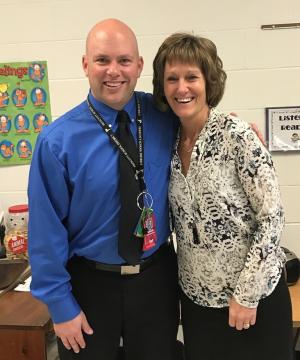Every day, teachers connect with students, their families, administration, and the community at large. We know all too well that a lack of connection will impact the building of relationships and the learning that occurs. The reality of college teaching is that connections with students vacillate and dissipate as students earn their degree and move into the teaching profession. Knowing this, it seems I work even harder to build connections with college students and treasure the associations with them during the four-year time frame. Some of my most joyful and rewarding moments is when I can reconnect with former students.
Three years ago, when our men’s organization began, one of our strategic goals was to connect the current male students to male teachers in early childhood classrooms. It was then that I discovered that Mr. Corey Morning, a former graduate of the program, was only an hour away from the university! Corey graciously accepted the invitation to join our first panel of teachers to speak with the male students enrolled in the program. He has since become one of our strongest advocates for the men’s organization serving as a mentor for the young men and a guest speaker. Corey has not only been supportive in the men’s organization but has assisted in my research.
Currently I am working to identify specific activities and strategies that support the dispositions (trustworthy, humor, compassion, and industrious) male early childhood teachers use to engage students in learning. The methodology includes observing and conducting interviews of male early childhood teachers in the field. The make-up of the pool of male teachers includes some former graduates from the early childhood program. These teachers have accepted the invitation to participate in the study and have welcomed Dylan, a current male early childhood student, and myself to visit their classrooms. During the week of April 15th, we visited the first-grade classroom of Mr. Corey Morning to observe the strategies he uses to engage students in learning. Dylan and I were impressed at how Corey delicately intertwined humor, compassion, trust, and respect to engage children (and us) in learning.
Corey’s facial expressions and the tone of his voice exhibit the disposition of humor. The light hearted, yet respectful way he communicates with his group of children keeps them attentive, challenged, and valued. Corey displays compassion and builds trust naturally through his interactions with the children but these dispositions are also apparent in his classroom environment. Various posters that adorn his classroom emphasize kindness, thoughtfulness, and respect for one another. One powerful example of respect came when the students were working at the Promethean board. After the child wrote down his/her response, they were to hand the marking tool to another friend. I noticed right away that a girl chose a boy and a boy chose a girl for the next turn. At one point, Corey reminded the male student that ‘out of respect for the girls, we need to choose a girl’.
Corey ultimately trusts the students to make good choices evident during their rotation times. He also encourages students to use hand signals when identifying their needs. Corey has a full time special education aide in his classroom. She spoke to me about Corey’s ability to set high standards for all his students especially those who struggle with learning and to trust they will succeed.
Making connections with his students, parents, and colleagues is certainly one of the many attributes and strengths Corey has as a teacher. As a current student in the program, Dylan was impressed with Corey’s classroom style and vital interactions created with the children and with he and me. Dylan has requested to visit Corey’s classroom again in the fall as Corey begins again to create the environment we observed.
There are no words to describe how impressed and amazed both Dylan and I were to see the way Mr. Corey Morning used the dispositions of humor, trust, respect, and compassion to create an environment conducive to learning.
The ripple effect of connecting with one another in this teaching profession is a crucial element in sustaining us in this profession. Whether a student is enrolled in a teacher licensure program, a new teacher, a seasoned teacher, or a professor, the interactions and relationships we create continue to develop our dispositions while cultivating and affirming the joy of teaching.

